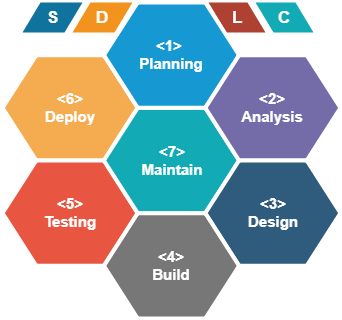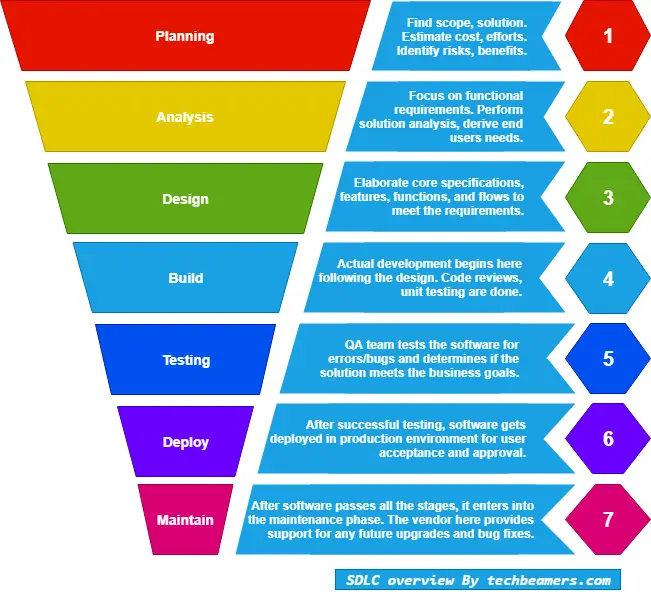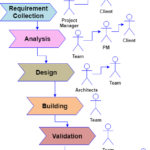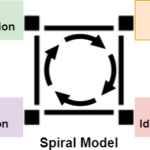Software Development Life Cycle (SDLC) is the most popular approach for releasing high-quality software products. It carries out the development in stages known as SDLC phases. The successful completion of each stage ensures that the final product gets released on time without any cost overrun and meets the customer’s expectations.
SDLC is an abbreviation for the Software Development Life Cycle. Another popular name for SDLC is the Software Development Process. The global standard behind SDLC is ISO/IEC 12207 which outlines all the tasks needed for planning, building, testing, and maintaining a software product.
Software Development Life Cycle – SDLC
SDLC Process
SDLC is a methodology for developing a software product adopted by most software organizations. It includes a comprehensive plan outlining how to code, maintain, patch, and remodel or improve the specific software. The life cycle represents a process for enhancing the quality of software and the entire development cycle. Each phase of SDLC produces outputs that act as inputs for the next stage. The requirements translate into the design. The developers pick the design specs, write the code, and produce a build. Testers validate the developed product as per the requirement. After completing the testing, the product gets shipped for deployment.
The following diagram is a pictorial representation of the several stages of a conventional SDLC.
SDLC Phases
The Software Development Life Cycle comprises the following phases:
1. Planning Phase
It is the very first SDLC phase that determines whether there is a need or not for a new system to fulfill the strategic business objectives. After that, a high-level plan is worked out with a business intent to procure the resources required for creating, modifying, or upgrading a service or solution. The goal of this step is to define the scope of the problem and devise solutions. The term resources refer to the HW/SW requirement, costs, time, benefits, and a few other essential items.
QA (quality assurance) activity identification, and project risk assessment also happen in this phase. Next, the feasibility study is a kind of technical analysis that aims to find out the most efficient ways to complete the project without any risk.
2. Analysis Phase
This phase begins with the team collecting and assessing the functional requirement of the project. It is one of SDLC’s initial and critical stages. It gets carried out by the senior developers/testers of the team with information from the client, the pre-sales, market studies, and domain specialists of the industry. These inputs help in planning the project approach and to perform the feasibility analysis based on the financial, operational, and technical aspects.
After getting through the requirement analysis, the next activity is to publish a clear definition of each of them in the form of a document. You suppose to share it with the customer or with the business analyst for approval. This artifact is the Software Requirement Specification a.k.a. SRS. It lists every product requirement with sufficient details needed to start the design and development activities.
3. Design Phase
The third SDLC phase involves solution design and documentation. SRS details act as the single point of reference for Software architects to chart out the best design for product development. Usually, it is a practice to come out with multiple solutions and prepare a Design Document Specification a.k.a. DDS with a detailed solution approach.
Now, the DDS has to go through approvals from all the key stakeholders. Several factors like risks, robustness, modularity, cost, and timelines play significant roles in deciding upon the design approach for the implementation.
The final design solution mentions what all modules should have, their architecture, workflows, entity, and data-flow diagrams along with the third-party dependencies if any. The DDS should even provide a clear view of the internal structure of the components to prevent any confusion later.
4. Build Phase
This stage has many names such as the Development or Coding or Implementation phase.
It is where the real development begins by following the design guidelines. The dev team writes code for each module as per the definition laid down by the DDS. A well-written design document that has sufficient, structured, and apt details, can make coding relatively easy and assist the developer to finish on time.
Every organization has a sort of coding standards, guidelines, and best practices that intend to produce quality and reusable code. All programmers should know and practice them while working on a development task. He or she must be mindful of the IDE, compilers (e.g., GCC/MSVC), interpreters (e.g., Python LINT), and debuggers (e.g., WINDBG, GDB). The selection of the programming language depends upon the nature of the software to build and also its ability to develop faster.
5. Testing Phase
Alias – QA/Validation phase
Some testing happens in almost all the stages of the Software Development Life Cycle. For example: Reviewing the SRS, DDS, unit testing of individual modules, and all such activities are some forms of validation. Even though, the product requires extensive testing to confirm that each component and all the functionalities work in line with the customer’s requirements. Also, it is a formal phase of the SDLC in which the QA team produces a testing plan, writes test cases, logs defects, performs regression, and makes sure the software attains the highest quality standard.
6. Deployment Phase
Alias – Acceptance or Beta evaluation phase
After the Software testing finishes successfully, the product gets ready to ship to the customer for deployment. In some organizations, they split this phase into sub-phases as per their business policies. They first do a release specifically for a market-facing group of people and gets it tested in a real-time environment for their acceptance. It is a sort of User Acceptance Testing a.k.a. UAT.
Their inputs may lead to fixing some usability bugs or enhancements crucial for the market perspective or can also give a green status for delivering it to the target customers. After the product is out for delivery to the market, it enters into the maintenance phase.
7. Maintenance Phase
Alias – Operations phase
After the software clears all the SDLC phases without any issues, then it goes into the maintenance stage. It allows the customers to request upgrades and get the fixes/patches for problems internally or externally identified. Most software companies adhere to all seven steps to deliver the product with the maximum possible quality.
SDLC Infographic
This section outlines and describes the seven SDLC phases with the help of an intuitive infographic. It can quickly help you understand what each of the stages is meant for in SDLC.
Software Development Life Cycle (SDLC) Types
The industry has received a no. of Software Development Life Cycle models over the years. Incrementally, each of them has come up with a solution to some technical or business problem and tried to improve the ability to deliver to the market. Since all these models result in a process, hence we can even call them the Software Development Process Models.
Below is the list of SDLC models which have gained popularity and been accepted industry-wide throughout the years.
There are several other development practices such as the RAD (Rapid Application Development) Process, and Extreme programming models.










